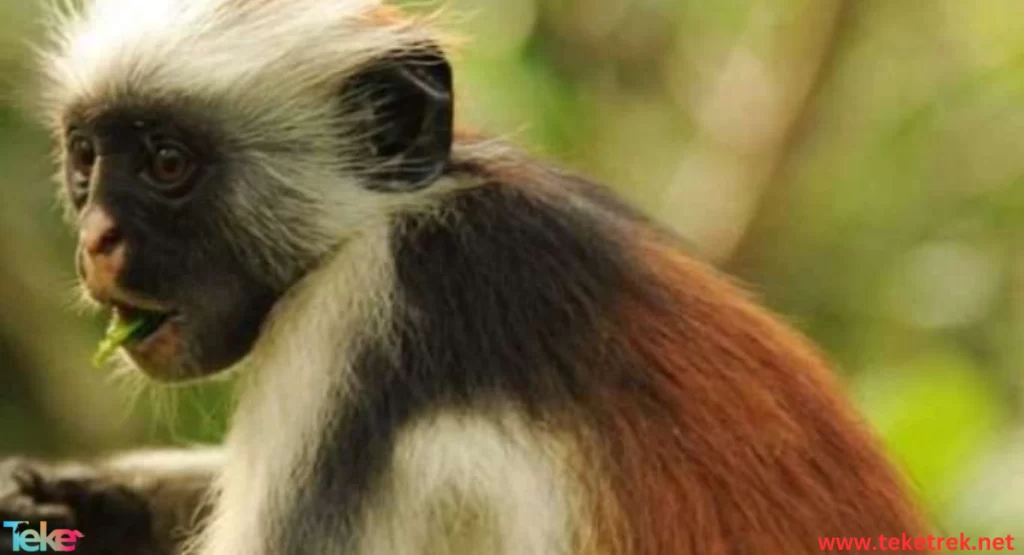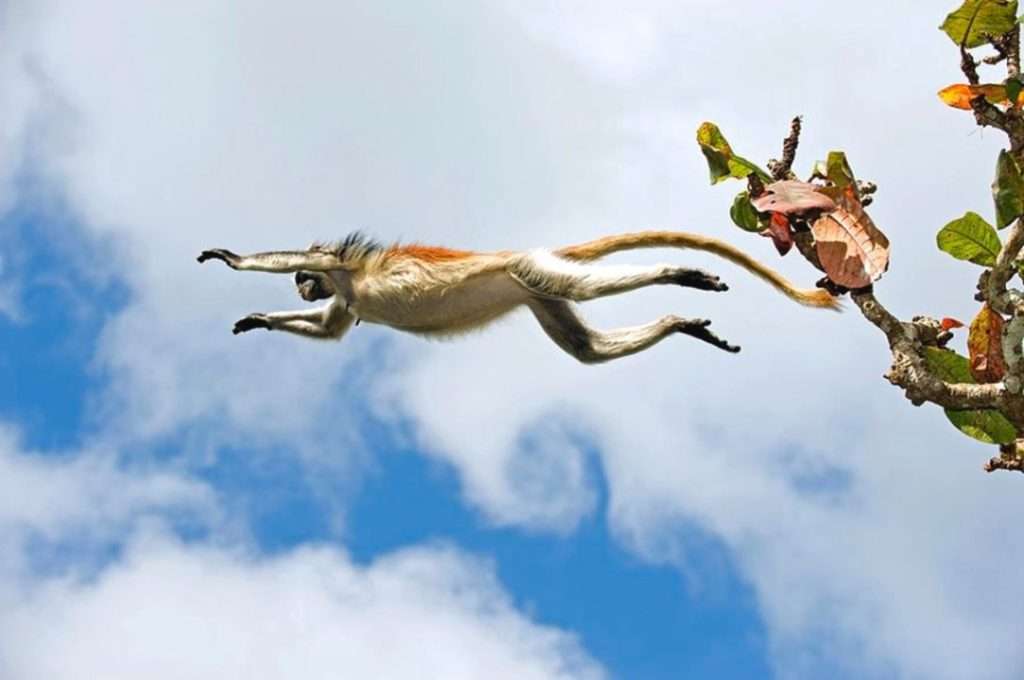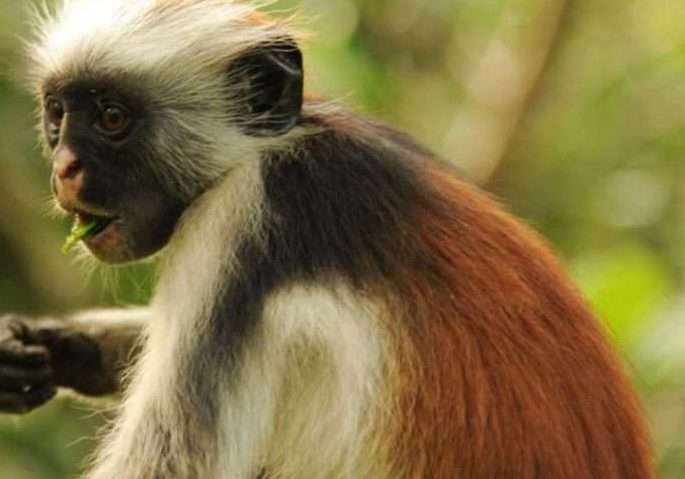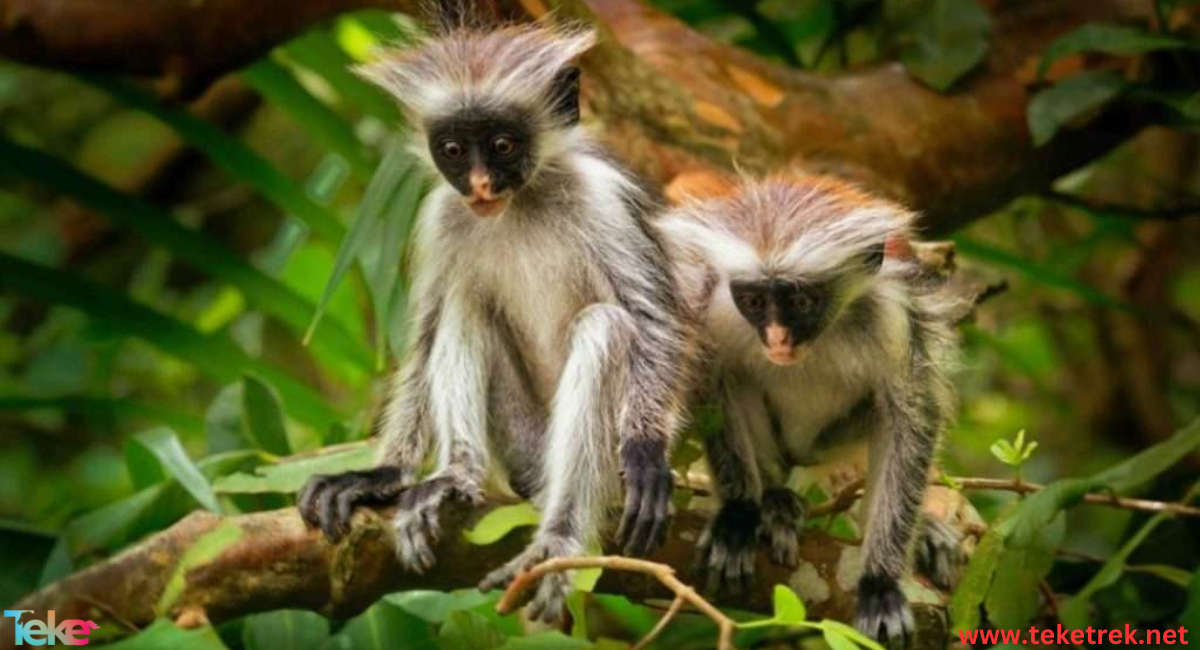The Zanzibar red monkey spends its life playing and performing acrobatic movements to be like a jungle clown. Today in TekeTrek we will tell you more about it in this article, how it lives, reproduces, and feeds, and I will present to you the most important facts about this beautiful creature.

An introduction to the Zanzibar red monkey
The Zanzibar red monkey is an animal from the mammal family:
- Its size ranges from 18 to 30 inches (45-70 cm).
- While the length of its tail ranges between 2 to 2.5 feet (55-77 cm).
- Males weigh over 26 pounds (12 kg), while females weigh 22 pounds (10 kg).
- The male and female are so similar to each other that they cannot be distinguished, but there is a slight difference in body color and size. Females are thinner than males, males have broader shoulders, larger skulls, and longer tusks.
- Some red monkey species have a lifespan of about 20 years in the wild.
- Its color ranges from dark red to black. It is characterized by a black line along the shoulders and arms. The lower part is pale. Their faces are black, with long white hair on top. The nose and lips are marked with a pink mark.
- It uses its long tail for balance, its hind legs for jumping, and its facial features help distinguish individuals.
- They possess noticeably lower opposable thumbs that help them move through trees and achieve the acrobatic nature of their movement through their environment.
Red monkey habitats Zanzibar
The Zanzibar red monkey is endemic to Angola, the main island in the Zanzibar archipelago, off the coast of Tanzania.
- It lives in trees in three forests inside the island, but prefers drier areas.
- It also lives in rag bushes and coastal forests, and you may find it in mangrove swamps and known agricultural areas.
- Red monkey home ranges range in size from 1.2-21.8 acres (0.5-8.8 hectares).
- The home ranges of neighboring groups also overlap significantly, with the average percentage overlap ranging from 6.9% to 42.9%.
Reproduction in the Zanzibar red monkey
The Zanzibar red monkey is a mammal that reproduces by birth. The female Zanzibar red monkey may mate with several males:
- The male reaches sexual maturity at the age of approximately three to three and a half years, while the female reaches at the age of two years.
- The female’s reproductive area swells and becomes red during estrus. Before mating, males examine the female’s vagina with their fingers, then sniff her to ensure she is ready to reproduce.
- After that, the pregnancy period lasts about six months, and the female may sometimes give birth to twins.
- The child is then weaned at an age ranging from one to three years, during which the young cling to their mother’s stomach for the first six months of their life.
- Boys start eating foods at the age of two to three years.
- Parents leave the children at three to four years of age and they begin to breed with members of other groups.
- Adult female red monkeys do most of the grooming and care for adult males, and also prepare and clean the offspring.

Behaviors and lifestyle of the red monkey
The Zanzibar red monkey plays in farmland groups much more than those inhabiting forests, perhaps due to shorter daily travel times of farmland groups, spatial cohesion, and desire to spend more time on the ground. The Zanzibar red monkey is considered very social, living in groups:
- Group size ranges from 30 to 50 individuals, consisting of four adult males and several females.
- A dominance hierarchy exists among group males, and two forms of social presentation have been observed: submissive submission by adult females and juveniles to adult males, and another in which dominant males make their appearances primarily to subordinate males to reinforce the dominance hierarchy.
- Socially integrated groups also divide into groups in search of food.
- Isolated males have been observed representing dispersal or migration to new groups, as a result of the lack of predators in the Zanzibar archipelago.
- Groups are tolerant of each other, but the rate of conflict between them increases when population density increases, creating competition for food, as in agricultural areas.
Food and environmental role of Zanzibar
The Zanzibar red monkey is an herbivorous animal that eats leaves and fruits, so it plays a major ideological role in the environment, as it:
- It contributes to seed dispersal and, as a result, plays a crucial role as an indicator of forest health.
- It also dramatically strips trees of their young leaves, stimulating them to recover by producing new clusters within a week, which increases their productivity and growth rate.
Strange interesting facts about the red monkey
Among the most prominent facts about the Zanzibar red monkey:
- It is called “Kema Bongo” or as it means in Swahili “poisoned monkey” due to its pungent smell.
- The Zanzibar red monkey is called Kirk’s red colobus, after Sir John Kirk, a British resident of Zanzibar.
- The Zanzibar red monkey’s jumps reach up to 25 feet (7.6 meters).


FAQ
The most common questions about the Zanzibar red monkey:
- How big is the red monkey?
Ranges from 18 to 30 inches.
- Why is the red monkey called the poisonous monkey?
Because of its pungent smell.
- How does Zanzibar move?
It uses its long tail for balance, and its hind legs for jumping.
- How long is a red monkey’s tail?
It ranges between (55-77 cm).
- How much does a red monkey weigh?
The male weighs 26 pounds, while the female weighs 22 pounds.
- Why is Zanzibar called Kirk’s Red Colobus?
Named after Sir John Kirk, who lives in Zanzibar.
- How does the Zanzibar red monkey reproduce?
The Zanzibar red monkey reproduces by birth.
- Why are Zanzibar red colobus endangered?
Zanzibar red colobus is endangered due to habitat destruction, hunting, and the illegal pet trade.
- How big are Zanzibar red colobus?
Zanzibar red colobus are medium-sized monkeys, with males weighing around 10-14 lbs. and females around 7-11 lbs.
- Why is Zanzibar so famous (Zanzibar red colobus)?
Zanzibar is famous for its red colobus monkeys, which are endemic to the island and considered endangered.
- Does a platypus give milk or lay eggs?
The platypus is a monotreme, so it lays eggs and then nurses its young with milk.
- Is a platypus a friendly animal?
Platypuses are generally shy so they are not considered friendly towards humans.
- Is a platypus a duck?
No, a platypus is not a duck. It is a unique mammal with characteristics of both mammals and reptiles.


In short, the Zanzibar red monkey is a forest-dwelling herbivorous mammal that feeds on leaves and fruit, reproduces by birth, and has a large ecological footprint.






